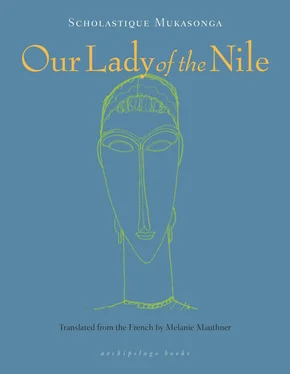With the two military jeeps in the lead, the motorcade exited the gates, drove down the track, and disappeared behind the curtain of rain.
Queen Fabiola’s visit nourished the girls’ conversations for a long time to come. They regretted it had been such a brief visit, and that the fabulous program they’d spent so long so carefully preparing hadn’t been able to take place as planned: the choristers and dancers were the most sour. Why was the Queen in such a rush? It seemed quite shocking. Do queens always walk that fast? Or all self-respecting women? It was clear evidence of the bad manners of white people. Veronica gave the example of the bamikazi of olden times, who knew how to move with dignified slowness, as if counting their every step, no one would have dreamed of asking them to hurry up, like that man with the watch seemed to be doing: time was for the bamikazi to decide. Gloriosa immediately replied that those queens were Tutsi, meaning lazybones who’d never lifted a hoe, parasites feeding on the labor of the poor. And that those weren’t good manners for true Rwandan women.
Modesta remarked that with all the bracelets and anklets they wore, the bamikazi couldn’t walk without being supported.
The discussion centered mainly on Fabiola’s beauty. Most of them found her extremely beautiful, more beautiful than Madame de Decker, and white, whiter even than all the white women in the capital. Indeed, everything about her was white: she wore a white skirt, a white jacket a bit like a man’s, white shoes that remained pristine — they wondered how she managed that. Some regretted that she hadn’t worn a long dress with a train, a real queen’s dress, like in their history book, like Cinderella’s dress. Immaculée sententiously explained that the Queen was wearing a suit, and that that was how the women dressed over there, in Europe.
“She’s no more beautiful than Queen Gicanda,” Veronica couldn’t help remarking.
“Your former queen!” Gloriosa burst out. “Her so-called beauty didn’t do her much good. I don’t foresee a great future for her, locked up in her Butare villa. And you Tutsi, you always think you’re the most beautiful in the world, but beauty’s switched sides now. Your supposed beauty will bring you misfortune.”
And then there was the hat. The mystery of the hat. An enormous hat, white too, with pink silk bows, feathers, and flowers, a real garden, the Garden of Eden, as Father Herménégilde would have said. How did it manage to stay in place beneath the hood that protected Fabiola from the rain? Did she put it on under the umbrella before she entered the hall? That was the mystery. However she managed it, they were all agreed, it was a real queen’s hat, better than a crown. Never had anything like it been seen in Rwanda. Only a queen could bear such a monument on her head.
They waited impatiently for news of Godelive. Had the King and Queen taken the President’s daughter with them? Had they really adopted her as their own daughter? And had Godelive, the lady-in-waiting, accompanied them on the plane? They asked Sister Gertrude, who listened to the radio, whether she’d heard anything. Nothing was said on the radio. They sent letters to everyone they knew in the capital, particularly their girlfriends. They pieced together all the fragments of the story. What did turn out to be true was that the President really had intended to offer the Belgian royal couple one of his daughters. He’d taken pity on the childless King, and had willingly offered up one of his daughters to preserve the lineage. He hoped that this way, the Belgians would always be on the side of the majority people, as they had been at Rwanda’s independence. He was joining the family: for the honor of their shared child, they wouldn’t let him down. But the King and Queen hadn’t grasped the matter. There are some things that whites will never understand. The Belgians had replied that of course the President’s daughter could study in Belgium. That went without saying. But when it came to the gift of a child, they feigned not to hear, or to understand. The President’s daughter stayed put, and so did Godelive.
“I was right,” said Goretti. “Nothing but tall tales. Godelive is so stupid she ended up believing her own lies.”
“We’ll see what she has to say for herself when she gets back,” the others ventured.
Godelive never returned to the lycée. She felt too humiliated to face the mocking of her schoolmates. But she did go to Belgium. Her father found her a chic boarding school. It was rumored that Mother Superior had something to do with that.
“Modesta,” said Gloriosa, “have you ever taken a good look at the Virgin’s face?”
“Which one?”
“Our Lady of the Nile, the statue.”
“Yes, and? Sure, it’s not like the other Marys. It’s black. The whites put black makeup on her. Probably to please us Rwandans, but her son in the chapel, well, he remained white.”
“But did you notice her nose? It’s a straight little nose, a Tutsi nose.”
“They took a white Virgin, painted her black, and kept that white nose.”
“Yes, but now she’s black, it’s a Tutsi nose.”
“You know, back then, whites and missionaries were on the Tutsi side. So a black Virgin with a Tutsi nose was a good thing for them.”
“Yes, but I don’t want a Holy Virgin with a Tutsi nose. I no longer want to pray before a statue with a Tutsi nose.”
“What can you do! You think Mother Superior or Monsignor would really change the statue if you asked them to? Unless you talk to your dad …”
“Of course I’ll talk to my dad … In fact, he said they plan to de-Tutsify schools and government. It’s already started in Kigali and at Butare University. You and me, we’ll begin by de-Tutsifying the Holy Virgin. I’m going to correct her nose, and there’ll be some girls who’ll understand the warning.”
“You want to break the statue’s nose! When they find out it’s you who did it, you’ll probably get expelled.”
“Don’t be so sure, I’ll explain to everyone why I had to do it: it’s a political gesture, so they’ll more likely congratulate me, and then there’s my dad …”
“So, how are you going to do it?”
“It’s not difficult: we smash the statue’s nose and stick a new nose on. We’ll go to the Batwa one Sunday, there are some in Kanazi. We’ll get some clay, nicely prepared and mixed, the kind they make pots with, and we’ll mold Mary a new nose.”
“And when will you stick this new nose on?”
“We’ll go at night, the day before the pilgrimage, so the next morning everyone will see Our Lady of the Nile with a new nose. A true Rwandan’s nose, the nose of the majority people. Everyone will appreciate it. Even Mother Superior. No need to explain it to her. Or rather yes, I’ll explain it to them. I know a few who’ll lower their heads, trying to hide their small noses. You’ll be first, Modesta, with your mother’s nose. But you’ll help me because you’re my friend.”
“I’m scared, Gloriosa. You’ll still get into trouble, and I certainly will too if I help you.”
“No, you won’t, we’re militants, I’m telling you. What we’re going to do is a militant act, and what with my dad, nobody will dare say a thing. They’ll be obliged to change the statue and replace it with another one, a real Rwandan lady with a majority nose. You’ll see, the Party will congratulate us. We’ll be women politicians. One day we’ll become ministers.”
“You definitely, but me, I doubt it.”
Gloriosa’s plan bothered Modesta. She hoped her friend would stop thinking about it, that she’d give up on it soon. The pilgrimage was a month away, by then Gloriosa would have probably forgotten about the whole thing. What she’d said was just a joke, idle chatter to pass the time, because life is so monotonous at the lycée of Our Lady of the Nile that you get some strange ideas sometimes. There are girls who imagine that a white teacher has fallen in love with them, that he’ll whisk them off, steal them away, just because he looks at no one else in class, so they’ll leave with him in a Sabena plane; others say the Virgin talks to them at night and they write down everything she says in a notebook; some girls believe themselves to be queens from olden times, nobody can touch them, so precious, so fragile, always on the verge of fainting; others say they’re going to die because they’ve been poisoned, poisoned for being too beautiful, more beautiful than all the rest, the jealous girls are after them with all kinds of evil spells, and they can’t eat a thing because there’s poison everywhere. These are bad ideas that whirl and clatter inside girls’ heads, sometimes they remain there, sometimes they vanish. Modesta hoped Gloriosa’s bad idea had disappeared like so many others.
Читать дальше












